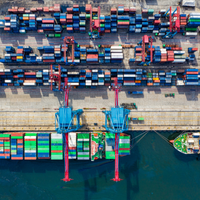Trade Finance for Treasurers
23-11-2021 | Wim Kok | treasuryXL | LinkedIn
The current global trading environment has exposed new complexities and heightened risks associated with international trade, notably through Covid 19. Following the latest studies (* ADB) the global trade finance gap grew to an all-time high of USD 1,7 trillion. Especially for SME sector (being hardest hit) the availability of bank liquidity and credit is increasingly under pressure. As a result, the playing field of international trade needs greater focus on understanding and mitigating risks and making use of new opportunities in the accelerating digital world of Trade Finance.
“Following the latest studies (* ADB) the global trade finance gap grew to an all-time high of USD 1,7 trillion.”

The ability to quickly access cost-effective financing when and where it is needed is key for also treasury departments. The new challenges and rapid changing finance landscape prompts many Corporate Treasurers to re-educate themselves and/or seek specialized expertise from trusted advisors, identify new and reliable alternative funding sources, streamline their digital journeys and current (internal) processes to achieve additional efficiency, transparency and cost reduction.
The use of Trade Finance solutions via (mostly standard and “old”) banking products goes way back in history to the golden age (Bill of exchange and promissory note financing). Our TreasuryXL expert Wim Kok can guide and advise you on the roles of banks and other key players, including emerging Fintech providers, insurers and alternative providers. It is essential for the Treasury department to address the needs and or pain points of the company select the most appropriate solution or partner to solve the problems or make use of new opportunities.
To give you an idea of the regular trade finance products that are available to facilitate trade, we list the instruments below.
Why is Trade Finance so Important to Corporate Treasurers?
- Obtaining liquidity using risk mitigation and financing options from international trade transactions
- The role of banks in trade finance products (risk mitigation / financing and transaction processing)
- Obtaining insight into the various trading conditions (Incoterms), the additional securities (title of documents, warehouse warrants) and credit insurance principles
Below is a brief overview of the most commonly used trade finance instruments, i.e.
- Documentary Letters of Credit (import, export), Stand-by LCs, Guarantees and Indemnities.
- Documentary Collections (CAA, CAD) – Bills of exchange and Promissory notes. Obtaining liquidity through discounting the instruments (with or without recourse).
Besides the classical trade finance banking products liquidity techniques such Receivable Finance or the Factoring of complete debtor portfolios (with or without credit insurance) are also frequently in the industry.
Your TreasuryXL trusted advisor Wim Kok is available for advice on the use of the various trade finance products or techniques.
Whereas the majority of trade finance products are (mostly) standardized and in international accepted format that are subject and adhere to the various international rules issued by the ICC** to name a few: UCP 600, ISP98, URDG758 and Incoterms etc.
International Business Consultant
Trade Finance Specialist
*The global trade finance gap grew to an all-time high of $1.7 trillion in 2020, a 15% increase from two years earlier, as the pandemic heightened economic and financial uncertainties and devastated global trade, according to the latest Trade Finance Gaps, Growth, and Jobs Survey, released today by the Asian Development Bank (ADB).
**ICC Headquarters 33-43 avenue du Président Wilson 75116 Paris, France Tel: +33 (0) 1 49 53 28 28 Fax: + 33 (0) 1 86 26 67 44 Email: [email protected]




